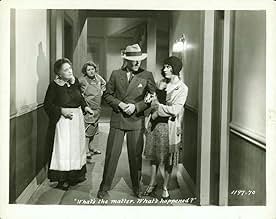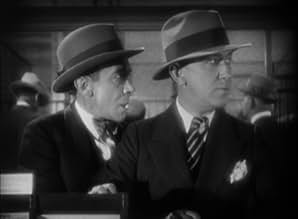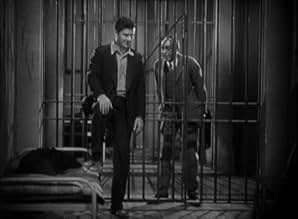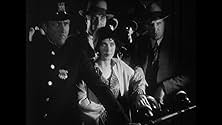Thunderbolt, big boss de Harlem, apprend que Ritzy veut le quitter pour un employé de banque. Pour s'en débarrasser elle le livre à la police. Même depuis le couloir de la mort de Sing-Sing,... Tout lireThunderbolt, big boss de Harlem, apprend que Ritzy veut le quitter pour un employé de banque. Pour s'en débarrasser elle le livre à la police. Même depuis le couloir de la mort de Sing-Sing, Thunderbolt cherchera à éliminer son rival.Thunderbolt, big boss de Harlem, apprend que Ritzy veut le quitter pour un employé de banque. Pour s'en débarrasser elle le livre à la police. Même depuis le couloir de la mort de Sing-Sing, Thunderbolt cherchera à éliminer son rival.
- Réalisation
- Scénario
- Casting principal
- Nommé pour 1 Oscar
- 2 victoires et 1 nomination au total
Ernie Adams
- Thug in Bank at Robbery
- (non crédité)
Elmer Ballard
- Prisoner #8
- (non crédité)
Louise Beavers
- Black Cat Cafe Patron
- (non crédité)
Ed Brady
- Chuck - 1st Prisoner #5
- (non crédité)
Avis à la une
Nobody would argue that 1929 was a year of classic movies. Amongst the flotsam and jetsam however there's APPLAUSE and a few other good ones..... and this as well - almost. What a difference a top director and screenwriter can make!
This isn't a gangster film, it's an intelligently written character study and in-depth look into the mind of a mobster. You find writer Jules Furthman's name on virtually every other classic Hollywood picture of the 20s, 30s and 40s. His style was quality and his skill was creating believable engaging stories with real genuine characters. His story was further adapted by H Mankiewicz - who wrote the scripts for the probably the other half of the classics from this period. Needless to say - this is well written with fascinating and deeply faceted characters.
Josef von Sternberg directed this which by the look of it was his fiftieth talkie. Surely it's impossible that this was his first sound film? Being made in 1929, it's still a little experimental, not quite everything works so this is not one of his best pictures. Nevertheless he creates a brooding almost surreal atmosphere with real tension. That style intensifies significantly in the latter part of the film on death row which has an almost dream like feel about it.
The story is tense, the characters are believable, the production is innovative but this is not a perfect film. To enable clear sound recording, some but not all of the actors speak very slowly which sounds especially weird when the actor they're talking with is speaking normally. Actors had their own individual vocal coaches then with different techniques thus the inconsistency and maybe not being a native English speaker, von Sternberg probably didn't notice the subtle differences.
As great a director as he was, von Sternberg was given the impossible task of trying to make Fay Wray seem like a proper actress. Not even he could do that and predictably she's absolutely dreadful. As always she just projects that limp, whining and insipid expression to convey whatever emotion she's trying to express.
Whether she's pretending to be a hard as nails gangster's moll or a reformed, sweet and vulnerable fragile young thing she's that same bland, shallow character. Not only can't she act but in this she doesn't appear to be able to speak English - what on earth is that accent! She's meant to be a girl from the streets so why is she doing history's worst impression of Queen Mary? That two men could be besotted with this dull sour-faced non-entity completely stretches all credibility.
This isn't a gangster film, it's an intelligently written character study and in-depth look into the mind of a mobster. You find writer Jules Furthman's name on virtually every other classic Hollywood picture of the 20s, 30s and 40s. His style was quality and his skill was creating believable engaging stories with real genuine characters. His story was further adapted by H Mankiewicz - who wrote the scripts for the probably the other half of the classics from this period. Needless to say - this is well written with fascinating and deeply faceted characters.
Josef von Sternberg directed this which by the look of it was his fiftieth talkie. Surely it's impossible that this was his first sound film? Being made in 1929, it's still a little experimental, not quite everything works so this is not one of his best pictures. Nevertheless he creates a brooding almost surreal atmosphere with real tension. That style intensifies significantly in the latter part of the film on death row which has an almost dream like feel about it.
The story is tense, the characters are believable, the production is innovative but this is not a perfect film. To enable clear sound recording, some but not all of the actors speak very slowly which sounds especially weird when the actor they're talking with is speaking normally. Actors had their own individual vocal coaches then with different techniques thus the inconsistency and maybe not being a native English speaker, von Sternberg probably didn't notice the subtle differences.
As great a director as he was, von Sternberg was given the impossible task of trying to make Fay Wray seem like a proper actress. Not even he could do that and predictably she's absolutely dreadful. As always she just projects that limp, whining and insipid expression to convey whatever emotion she's trying to express.
Whether she's pretending to be a hard as nails gangster's moll or a reformed, sweet and vulnerable fragile young thing she's that same bland, shallow character. Not only can't she act but in this she doesn't appear to be able to speak English - what on earth is that accent! She's meant to be a girl from the streets so why is she doing history's worst impression of Queen Mary? That two men could be besotted with this dull sour-faced non-entity completely stretches all credibility.
If you can get past the really rather stilted production here - almost stage bound in it's presentation, this is quite an entertaining film that sees the authorities on the trail of the most wanted "Thunderbolt" (George Bancroft). He is elusive, though - and their only route to him might be through his ex-girfriend "Ritzie" (Fay Wray) - but she isn't playing ball for reasons of her own. It's only when "Thunderbolt" makes good on an earlier threat he made to her about seeing anyone else, that the police see some light. The performances are fine, not great but the writing is really quite good - plenty of quirky vernacular and it moves along well despite the frequent silent movie style direction and scene framing from Josef von Sternberg. There is also quite an enjoyable contribution from a blues ensemble and though certainly dated, this is still worth a watch almost 100 years later.
... at least for early sound. The title character in particular, Thunderbolt, played by George Bancroft, is a rather complex gangster character for a dawn of sound movie. What do you say about a man who'd go to great lengths to kill a fellow he has never met just on general principle but who loves the stray dog that causes him to finally get pinched and put in the death house to the point that when the death house warden grants him a favor, Thunderbolt asks for that same dog to stay in his cell as a pet? Fay Wray, only 21 at the time, plays Ritzy, Thunderbolt's girl, with a sense of world-weariness that is wise beyond her years. When the film opens she's being hassled by the police to give up Thunderbolt's hiding place in some really classic early sound police interrogation scenes. Ironically, she really wants to be free of Thunderbolt, who swears he'll never let her go, especially if there's another guy involved, and there is - bank teller Bob Morgan played by Richard Arlen.
The first third of the film moves about quite a bit with some great jazz age settings, but the last two-thirds is primarily confined to the death house where Thunderbolt awaits his appointment with the chair. There's lots of atmosphere in this one with the death row quartet that keeps getting broken up as one fellow is executed and then restarted as another inmate enters. The death row warden is an interesting fellow, with eccentricity and nervousness balanced by a humane streak to the point that he seems misplaced - he seems like he'd be happier managing the shoe department in some retail store.
The end has a surprise twist to it that makes Thunderbolt rethink his rather complex plan of revenge just as he makes that last walk to the chair. I'm being intentionally vague here so I don't ruin it for you. Watch it for the surprising sophistication of this early sound piece, for the kind of atmosphere you can always count on in a von Sternberg film, and for that general touch of class that you find in the early Paramount talkies.
The first third of the film moves about quite a bit with some great jazz age settings, but the last two-thirds is primarily confined to the death house where Thunderbolt awaits his appointment with the chair. There's lots of atmosphere in this one with the death row quartet that keeps getting broken up as one fellow is executed and then restarted as another inmate enters. The death row warden is an interesting fellow, with eccentricity and nervousness balanced by a humane streak to the point that he seems misplaced - he seems like he'd be happier managing the shoe department in some retail store.
The end has a surprise twist to it that makes Thunderbolt rethink his rather complex plan of revenge just as he makes that last walk to the chair. I'm being intentionally vague here so I don't ruin it for you. Watch it for the surprising sophistication of this early sound piece, for the kind of atmosphere you can always count on in a von Sternberg film, and for that general touch of class that you find in the early Paramount talkies.
The High-Light of this "First-Year" of the All-Talkie Hollywood in Renowned Director Sternberg Film is the Harlem Night-Club.
This Takes Place in the First Half and while the Remainder of this Gangster-Romance is Peppered with a Few Interesting Flourishes,
None Equate the Impressive Opening and Once the Movie Gets to Prison the Film is Absent Sternberg's Signature Touches.
In Face the Movie Grinds to a Halt and is just Uninteresting Banter and Prison's Inanimate Existence.
The Dialog Deliveries are Pause Laden, Rhythmic Readings that are Stiff, Laborious, and so Wearily Dated as to be Painful.
Fay Wray is Hardly a Presence, Richard Arlen is OK, and George Bancroft (Oscar Nominated) is Domineering but Hardly Special.
Overall, a Curiosity and Film Historians Should Give it a Look for Context and the Director's Complete Filmography.
But Casual Movie Fans and Seekers of some "Old-Stuff" are Likely to be Bored to Death and Very Disappointed.
This Takes Place in the First Half and while the Remainder of this Gangster-Romance is Peppered with a Few Interesting Flourishes,
None Equate the Impressive Opening and Once the Movie Gets to Prison the Film is Absent Sternberg's Signature Touches.
In Face the Movie Grinds to a Halt and is just Uninteresting Banter and Prison's Inanimate Existence.
The Dialog Deliveries are Pause Laden, Rhythmic Readings that are Stiff, Laborious, and so Wearily Dated as to be Painful.
Fay Wray is Hardly a Presence, Richard Arlen is OK, and George Bancroft (Oscar Nominated) is Domineering but Hardly Special.
Overall, a Curiosity and Film Historians Should Give it a Look for Context and the Director's Complete Filmography.
But Casual Movie Fans and Seekers of some "Old-Stuff" are Likely to be Bored to Death and Very Disappointed.
This film begins with the news that an elusive gangster nicknamed "Thunderbolt" (George Bancroft) is wanted for bank robbery and is considered armed and dangerous. That being said, as the film continues it is also revealed that Thunderbolt has a girlfriend named "Ritzi" (Fay Wray) that he is obsessed with. The problem is that Thunderbolt has become, not only extremely possessive of Ritzi, but somewhat abusive as well. So, because of that, Ritzi has since fallen in love with a gentle man named "Bob Moran" (Richard Arlen) who simply adores her. Needless to say, Thunderbolt becomes quite livid when he learns that Ritzi wants to break up with him because she has found another man. So much so that not even the death penalty can prevent him from getting his revenge. Now, rather than reveal any more, I will just say that I was pleasantly surprised with the menacing performance George Bancroft put in for this particular role. Absolutely outstanding. That being said, however, it's also quite obvious that all of the actors labored to some degree from the transition from silent films. An unfortunate byproduct of its time. Be that as it may, I still found this film to be entertaining for the most part and I have rated it accordingly. Slightly above average.
Le saviez-vous
- AnecdotesOne of the earliest of over 700 Paramount productions, filmed between 1929 and 1949, which were sold to MCA/Universal in 1958 for television distribution, and have been owned and controlled by MCA ever since. However, because of its extreme age, and primitive sound recording techniques, there is no record of it ever having been locally televised. On cable TV it received what may have been its first and only telecast on Turner Classic Movies in August 2016.
- Versions alternativesMade in both sound and silent versions.
Meilleurs choix
Connectez-vous pour évaluer et suivre la liste de favoris afin de recevoir des recommandations personnalisées
- How long is Thunderbolt?Alimenté par Alexa
Détails
- Date de sortie
- Pays d’origine
- Langue
- Aussi connu sous le nom de
- L'assommeur
- Lieux de tournage
- Société de production
- Voir plus de crédits d'entreprise sur IMDbPro
- Durée1 heure 25 minutes
- Couleur
Contribuer à cette page
Suggérer une modification ou ajouter du contenu manquant



































